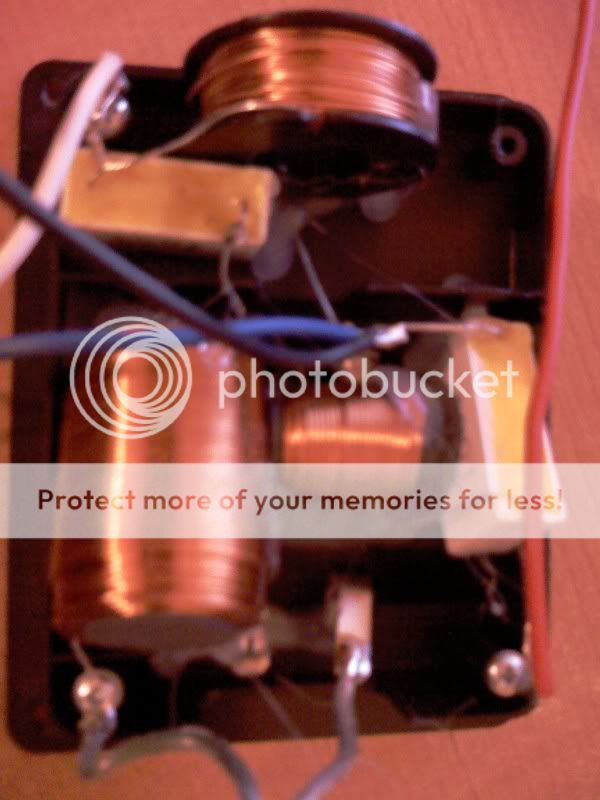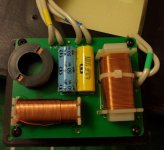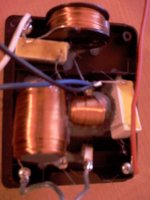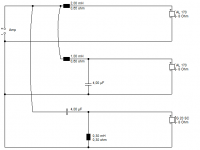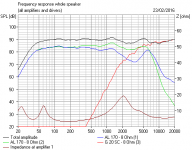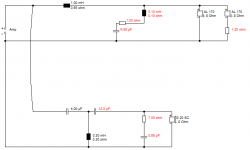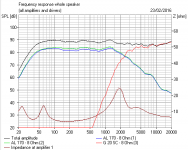Cant agree with the above unless you completely understand what you are doing at a theory level then have special measurement and analysing equipment. I'm sure you could improve the std xover design but I'm also sure you'd be in a world of pain too!
This is assumed in my post - of course you'd need to know what you're doing and have the right equipment, and if you have these things then there is no reason you would be in "world of pain."
If the "flaws" of the original parts were taken into account in the design of the crossover, then you will make the crossover with expensive "boutique"-parts worse!!!!imho, just upgrading cheap non audio focussed components for audio grade equiv parts will give large benifits without doing an electronic engineering / sound engineering degree!!!!
If the "flaws" of the original parts were taken into account in the design of the crossover, then you will make the crossover with expensive "boutique"-parts worse!!!!
This is true! We may as well shut the forum down and go home :-(
From my own experience, I'd just get rid of those caps for now and put something else in there that is known to be better for audio. The effect you are trying to achieve is to allow the music to flow through the components without changing the filter. Better components should achieve this. I'll eat my hat if it sounds worse!!!!! ;-)
I've changed caps in several speakers I've owned and in some friends too, never had the sound been effected in an adverse way!!!!
crossover silver 9i
I'm glad to see you are getting such a good response on this subject. I posted earlier on a similar topic and did not get any bites. I will be carefully watching your results since I have 5 of these speakers for a home theatre set-up.
I would suggest that you also upgrade the binding posts. I find mine to be marginal. The suggested idea of an outboard unit is certainly a good one.
Have you considered active? I don't know how you would handle the issue of 2.5 way with active crossovers.
Good luck...keep us posted on your results!
I'm glad to see you are getting such a good response on this subject. I posted earlier on a similar topic and did not get any bites. I will be carefully watching your results since I have 5 of these speakers for a home theatre set-up.
I would suggest that you also upgrade the binding posts. I find mine to be marginal. The suggested idea of an outboard unit is certainly a good one.
Have you considered active? I don't know how you would handle the issue of 2.5 way with active crossovers.
Good luck...keep us posted on your results!
Have you considered active? I don't know how you would handle the issue of 2.5 way with active crossovers.
A .5 speaker can be handled one of two ways with an active crossover. For fully active operation, it needs its own crossover channel and amp. IOW, you need a tweeter amp, mid-woof amp and .5 driver amp, just like a three-way. An alternative is to do a hybrid, active/passive; feed the .5 speaker from the mid-woof amp, but use an inductor on the .5 driver.
Going active is tricky. Speaker designs can incorporate tweaks that will be missed just by mimicking expected crossover slopes and points (e.g. zobel, notch filter, stepped response, different crossover points for each driver, etc,). You're almost doing a new design by going active. From experience, I'd recommend selling the Monitor Audio and starting over rather than try to convert to active. Or just upgrade the passive crossovers, as the OP intends.
Last edited:
crossover
Audiobomber:
So what do people do regarding these things such as you mention if they do go active? I have often wondered this, especially when reading about baffle step loss, etc. Do you design part of passive crossover and then go active, or can these things be done with dsp?
Thanks for your answers
Audiobomber:
So what do people do regarding these things such as you mention if they do go active? I have often wondered this, especially when reading about baffle step loss, etc. Do you design part of passive crossover and then go active, or can these things be done with dsp?
Thanks for your answers
Audiobomber:
So what do people do regarding these things such as you mention if they do go active? I have often wondered this, especially when reading about baffle step loss, etc. Do you design part of passive crossover and then go active, or can these things be done with dsp?
Thanks for your answers
It can all be done with an active crossover, but it's not trivial. You need good measuring equipment and some knowledge. Even then, there's no certainty you will exceed the original design if it's a really clever one. I have a pair of BESL S5-MTM speakers. Phil Bamberg is famous for his crossovers. I have no confidence that I could replicate the finer points of his design; the critical notch filter on the magnesium cones, a bypass for extra tweeter extension, time delay for the tweeter and who knows what else.
I bought a Marchand XM44 in the mistaken belief that I could just replace the crossovers in my Energy Ref Con speakers and achieve an improvement. I never got there, because I didn't know any of the finer points of design. I could give it a much better effort now and I *think* I could do better than the original. No guarantee though.
If/when I do another active design, it will be with very benign drivers of my own choice, no more ripping crossovers out of OEM designs.
This crossover is probably an inductor for the woofer, an inductor and capacitor in series for the mid, and a second order filter for the tweeter. Depending of how the three drivers over lap each other in the music you can move their crossover points up and down for less over lapping by adjusting the value of the capacitors. The tweeter has no resistor. You may want to add a 1 ohm resistor to the tweeter and see how that sounds. You can add it between the wire and one of the connectors of the tweeter.
Hi,
Its a 2.5way and the x/o is certainly not as described above.
Lower unit is rolled at off at ~ 600Hz by the cored inductor.
Upper unit is a 2nd order filter to roll it off at ~ 3KHz.
Tweeter has a 2nd order filter to bring it in at ~ 3KHz.
Probably the mid/treble low pass filter is applied to the
bass/mid driver and the bass driver with a series inductor,
in parallel, if it isn't, it is probably worth trying this.
Replacing a cored inductor for a 0.5 way driver with an
expensive air core is not going to be as effective as
you might think, compared to a bass/mid.
The speaker itself has some quirks :
Monitor Audio Silver 9i loudspeaker Measurements | Stereophile.com
rgds, sreten.
Its a 2.5way and the x/o is certainly not as described above.
Lower unit is rolled at off at ~ 600Hz by the cored inductor.
Upper unit is a 2nd order filter to roll it off at ~ 3KHz.
Tweeter has a 2nd order filter to bring it in at ~ 3KHz.
Probably the mid/treble low pass filter is applied to the
bass/mid driver and the bass driver with a series inductor,
in parallel, if it isn't, it is probably worth trying this.
Replacing a cored inductor for a 0.5 way driver with an
expensive air core is not going to be as effective as
you might think, compared to a bass/mid.
The speaker itself has some quirks :
Monitor Audio Silver 9i loudspeaker Measurements | Stereophile.com
rgds, sreten.
Last edited:
You can replace the capacitors with the better ones like Clarity Cap ESA 250V or V-Cap OIMP 250V.You don't need to replace the capacitors with the greater ones (bigger size and more expensive unless you like the sound from the capacitor which has greater voltage like Mundorf). If I were you, I will left the inductors untouched because every inductor has its DC resistance.If you change these inductors with air-core inductors which have different DC resistances you changed the sound of the whole system.Your speaker may not sound good after it has been modified unless you have software and measurement microphone to measure your system and do some adjustments.
Heya I finally find my old docs and photos, hopefully they are of some use.
How to
Unscrewed all the drivers and removed the cables (+ and - are marked.)
Unscrewed the cross over back plate.
removed the 4uF cap.removed the 8uF cap. replaced with cw 8uF and two caps in parallel 3.3uF and 0.68uF
(Audio-Grade Polypropylene Axial Capacitors)
Cladding
The cladding inside the silver 8i's is just foam... replace it with actual audio cladding for a couple of quid using the foam pieces as templates for the audio cladding.
Maplin Electronics : Order Online - Fast Delivery cladding
http://www.icwltd.co.uk> - capacitor manufacturer.
How to
Unscrewed all the drivers and removed the cables (+ and - are marked.)
Unscrewed the cross over back plate.
removed the 4uF cap.removed the 8uF cap. replaced with cw 8uF and two caps in parallel 3.3uF and 0.68uF
(Audio-Grade Polypropylene Axial Capacitors)
Cladding
The cladding inside the silver 8i's is just foam... replace it with actual audio cladding for a couple of quid using the foam pieces as templates for the audio cladding.
Maplin Electronics : Order Online - Fast Delivery cladding
http://www.icwltd.co.uk> - capacitor manufacturer.
I upgraded crossover components and went outboard with a pair of Energy 22 Reference Connoisseur speakers. I changed the existing polypropylene caps to Auricaps and there was a definite improvement, more air, detail and smoothness. I preferred the sound of Auricaps vs Solen, Hovland and a couple of others. I didn't try Mundorf. Some people recommend bypass caps. IME, bypassing works only in a shunt position (i.e. to bypass the driver, as in the woofer zobel). If you use parallel caps in series with the driver, you end up with sibilance.
The biggest bang I got was replacing the ferrite-cored woofer inductor with a Solen Hepta-Litz. Bass got much tighter, cleaner and more dynamic, which gave music a bouncier, more involving beat. I tried a ribbon inductor (Alpha-Core) and much preferred the Hepta-Litz. Select the Hepta-Litz gauge based on the DCR of your existing inductor. I didn't bother to replace the smaller air-cored inductors, just the ferrite core on the woofer.
Audiobomber, what gauge HeptaLitz did you use in your ref conns. I'm looking at doing some upgrades to mine including changing the internal wiring...is there anything else you recommend?
Auricaps are very good, and they have newer version - Auricap XO, which I can say better than Mundorf Supreme. About replacing coils: you should replace it with same resistance coil, so, ,easure it with simple LCR meter. For internal wiring you can use DH-Labs SH-18 or Auric hook-up (also 18AWG).Audiobomber, what gauge HeptaLitz did you use in your ref conns. I'm looking at doing some upgrades to mine including changing the internal wiring...is there anything else you recommend?
Do you chaps think that upgrading the cap for the mids (which is a lytic) but which shunts rather than passes like the tweeter cap is worth it? It is for my bedroom system so if the change is very subtle...I think I'll pass.
Currently I'm thinking that bypassing the tweetercap with a 0,01uF Vishay MKP1837 should do the trick.
Currently I'm thinking that bypassing the tweetercap with a 0,01uF Vishay MKP1837 should do the trick.
Last edited:
A bit of homework in order:
Monitor Audio Silver 9i loudspeaker | Stereophile.com
I can see some problems with this speaker. Specifically the two metal basses have significant output at 5kHz into harsh breakup region.
Below is what I think we decided was the simplistic crossover. TBH, I think it might work better with an MTM or here a TMM parallel arrangement and a 6kHz LCR notch if the basses share a cabinet volume. The 1.2R is just a modelling marker to separate the response graphs of the basses, and is not fitted.
The rest, 12uF and Zobel, on the tweeter filter is optional. But does something good IMO. I wonder what the DC resistance of the basses is? Must be around 10 ohms IMO. Fiddling with component types will make far less difference than a redesign IMO.
Monitor Audio Silver 9i loudspeaker | Stereophile.com
I can see some problems with this speaker. Specifically the two metal basses have significant output at 5kHz into harsh breakup region.
Below is what I think we decided was the simplistic crossover. TBH, I think it might work better with an MTM or here a TMM parallel arrangement and a 6kHz LCR notch if the basses share a cabinet volume. The 1.2R is just a modelling marker to separate the response graphs of the basses, and is not fitted.
The rest, 12uF and Zobel, on the tweeter filter is optional. But does something good IMO. I wonder what the DC resistance of the basses is? Must be around 10 ohms IMO. Fiddling with component types will make far less difference than a redesign IMO.
Attachments
I'll have a look.I wonder what the DC resistance of the basses is
Thanks for all the info. But I'm not all that driven to improve this speaker since it is just something for ambient music in my bedroom. I was mainly struck by the difference in filter appearance.Fiddling with component types will make far less difference than a redesign
- Status
- This old topic is closed. If you want to reopen this topic, contact a moderator using the "Report Post" button.
- Home
- Loudspeakers
- Multi-Way
- Upgrading crossover - Monitor Audio Silver 9
